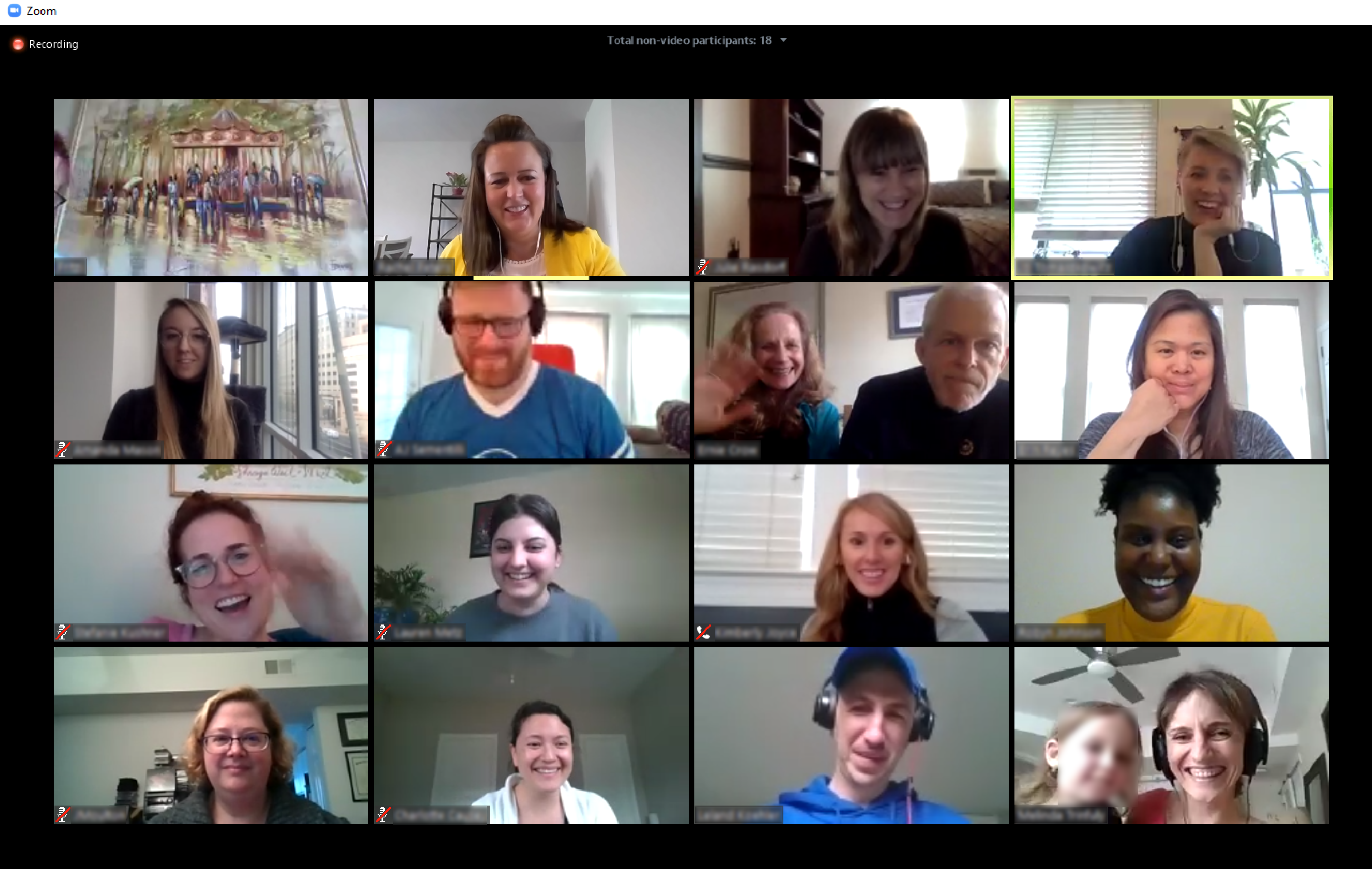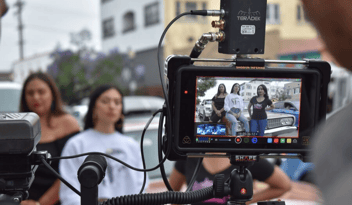Remote work is the new normal for many of us in response to COVID-19. Businesses have turned to virtual onboarding, and new hires are starting their "first day in the office" from their own living rooms!
As you prepare to begin your new role from home, you may be wondering what to expect in the coming weeks (or potentially months) as you start your job fully remote. From meeting your team virtually to acquiring technology and resources to training and staying connected, you're likely to face challenges along the way. At times like these, preparation is key to success, and there's no better way to prepare than by first knowing what others have experienced under similar circumstances. That's why we've turned to our new hires and hiring managers for answers! Here's what it's like to get hired fully remote during COVID-19 at two of our biggest client sites, a Fortune 500 tech company in the Bay area and one of the largest multinational pharmaceutical companies in the world.
The New Hire's Experience
Q: How has your onboarding experience been?
Senior Art Director, Kay: I was a little nervous about onboarding remotely since I prefer in-person introductions. There's just too much that can go wrong - delayed video, bad audio, in-home distractions! Luckily this process has been exceptionally smooth, and meeting everyone online worked well.
Production Coordinator, Emily: I had a very smooth onboarding experience. The team was very welcoming and helpful, and I had no problem adapting to the new role. I believe the natural progression into my new position with TeamPeople had a lot to do with the team I joined.
Webcast Producer, Marianne: The onboarding process generally went smoothly. The most challenging part was getting all of the permissions and accesses in order since many other companies and departments are not running normally.
Program Manager, Joseph: Overall, the TeamPeople onboarding side was straight forward and detailed. The documentation provided and information on benefits was beneficial.
Q. How do you stay connected with your team or manager? How are you getting to know people?
Kay: I'm staying connected with everyone through Teams and Zoom meetings. With Teams, we've started to do a few challenges to get everyone talking about things not directly related to work. We have a "recreate a famous painting" challenge coming up that I'm excited to participate in.
Emily: I’m in contact with my team and manager every single day, whether it be through Teams, texts, or video calls. We all take pride in being a small, close-knit group. The team is excellent at making everyone feel heard and free to express their opinions and ideas. I came from a background of Freelance Production and have always wanted a home company to grow with. I’ve found that with TeamPeople.
Joseph: I’m staying connected with my team via calls, Skype, Teams, emails, IM chats, and video conferencing. I enjoy the IMs since they’re not formal. On Fridays, we have virtual coffee time in the morning and happy hour in the evenings, and there is no talk about work. Instead, people talk about new or old hobbies, TV shows, and what they’re doing to mitigate the effects of work from home due to the pandemic.
Marianne: We use email, Skype, and WebEx meetings to stay connected. One of the managers even scheduled a virtual social hour, and it allowed me to get to know everyone better on a personal level.

Q. How have you had to adapt your expectations and experience since you started your new role remotely?
Kay: Going in, I made a point to mentally remove all expectations for what I thought the experience was going to be. We're in a time where it's hard to predict what the next two weeks could even look like, so flexibility is key. This has reduced my stress quite a bit and lets me roll with new directions easily.
Emily: Coming from a Freelance Production background, I’ve experienced many remote workdays with teams I’ve never met before. When it was announced that a mandatory work from home period was instilled, I wasn’t too worried. I knew this would in some ways make our team even stronger. Production isn’t easy remotely. It definitely created challenges for our team that we hadn’t thought about before the pandemic. However, we’ve collaborated to come up with virtual production plans that have made our clients very happy.
Joseph: My first day of work was everyone's last day in the office. I missed out on having a team lunch with my manager and team. I did not have my required equipment, so it had to be shipped to me. I’ve had to adapt by having a sound support system around me, even while social distancing. I get online earlier, since I don’t have a commute, and do a little research and catch up before everyone else is online.
Marianne: This adjustment has not been a problem for me, especially once I gained access to everything I needed. I used to work from home on non-production days just like we’re doing now.
Q. Have you found that you rely on specific skill sets more starting a role virtually vs. in-person?
Kay: I believe that communication is critical to successful remote work and a skill that should be heavily relied on. Knowing that I'm typically selective in what I say in meetings, I've made a point lately to share my thoughts more than I naturally would in-person.
Emily: I think working remotely really makes you hone in on your communication skills. Now more than ever, you need to be articulate; otherwise, misunderstandings can arise. From a production standpoint, we had to figure out ways to produce a full production on a virtual basis. Clear communication and relying on your team makes this possible.
Joseph: I’ve found that I’m building up my communication and phone skills. Being new to the team, it can sometimes be difficult to not see my coworkers’ expressions during our calls. I’m relying more so on speech since I’m missing out on body language and other non-verbal communications.
Marianne: The only real difference I’ve experienced is that we are meeting virtually instead of in person, so video conferencing skills are being utilized more than usual.
Q. Compare your past experiences starting a new role in-person to starting a new role fully remote.
Kay: Starting a new role on-site is vastly different than remotely. During the first few days on-site, you tour the building, meet and greet anyone you pass, have lunch with your new team, etc. On the other hand, getting hired fully remote, you grab your laptop and log in. Introductions occur at a much slower pace as they have to be scheduled. Overall, starting virtually doesn't require the "go go go" that being on-site typically entails.
Emily: I haven’t started a position virtually, but during this time, I have had to onboard a Freelance Producer because we needed the extra help. I put myself in her shoes and made sure I was able to supply her with the necessary resources to comfortably start her role. I also made it clear that I was there for her if she needed clarification on anything throughout her onboarding process.
Joseph: TeamPeople has been excellent at communicating with me, and overall, everything went well. I did miss out on the team lunch and meeting everyone in person, but I do feel that things are going smoothly.
Marianne: Starting a new position virtually is a slower pace than starting in-person, and it also hinders the social aspect of meeting all of your new coworkers.
The Hiring Manager's Experience
Q. How have you had to prepare, train, and onboard differently for a newly hired employee who is virtual vs. in-person?
Hiring Manager, David: Our team works across multiple sites, so I’m used to doing some remote coordination and training for new hires. I typically travel to be present for their first day in-office and help with badging, touring the office, meeting people, and some one-on-one training. I had to forgo that entirely in the case of our new hire, Marianne. Instead of a first day in the office, we had a first four hours of training and Q&A on WebEx.
Q. How does your team communicate?
David: We communicate primarily via email and IM. We have long had weekly production meetings, which we switched to video meetings for some ‘face time’ with the team. I also added a second weekly meeting for my TeamPeople staff as a 'check-in'. Having our new hire, Marianne, participate in those has been a great way for her to get to know her teammates, their roles, voices, and personalities.
Q. How do you set expectations?
David: Training is a perfect time to set expectations. I worked through ‘the life of a project’ with Marianne so she could learn what needs to happen, expectations for turnaround, etc. Especially having her shadow on customer meetings is helpful for demonstrating the tone and rapport our clients expect.
Q. What are some of the biggest obstacles you’ve experienced, and how did you get around them?
David: Getting Marianne ‘plugged in’ to our online tools was the biggest hurdle. With the work from home orders in place, it’s not an easy time to physically get a laptop from the IT department for a new hire. It took some coordination to finally set a time when Marianne could meet someone from our team as a host on-site to pick up her laptop, finish the configuration, and confirm VPN access was configured properly.
Q. What things have been successful in getting a newly hired employee up to speed?
David: Working through example projects with screen sharing and plenty of time to answer questions has been very effective. Having shareable templates that Marianne could work from, and then reviewing her work, also worked well. After the first couple weeks of working from home, our team had a virtual happy hour which was a great opportunity for everyone to get to know Marianne better as a person and vice-versa.
Q. Why was it critical for your new hire to start their role fully remote rather than waiting until the lockdown is lifted to begin in person?
David: Our team has been very busy supporting remote meetings and important communications. Initially, there was a company-wide scramble to different communication platforms, but we quickly adapted to a remote-presenting model that has become very popular, and it was important to have the extra bandwidth to coordinate them. I’m glad we were able to get Marianne up to speed and able to start helping engage new events.
Q. How has your overall experience been?
David: It’s been challenging at times, but having done some remote training and support already made it easier. I’m grateful we were still able to bring a new hire on at this time and that everyone involved was so understanding of the situation and cooperative in helping make everything happen for a unique (and successful!) onboarding experience.
TeamPeople's Experience
As for closing remarks, Senior Art Director, Kay, says it best: "The last thing I want to note is to remember that everyone is doing their best. We're all experiencing this pandemic in different ways so keep an open mind, be flexible, and make sure to take some time for your own mental health!"
Although hiring has slowed across the nation, we’re happy that many of our client sites have seen an uptick in hiring since lockdowns were put into effect surrounding COVID-19. We’re here and ready to continue supporting job seekers, our clients, and those in the community as we face the future together. If you’ve accepted an offer and are required to start your new role fully remote, we hope this feedback from our on-site teams will come in handy to gauge what to expect in starting your new role from home!
Looking for work? At TeamPeople, we offer a wide range of job opportunities across industries and professions, from creative to technical and everything in between. Head to our talent page to learn about the perks of pursuing your passions at TeamPeople or check out our job board to see our current list of open opportunities.



